Entries tagged with “ShooTag”.
Did you find what you wanted?
Wed 9 Nov 2011
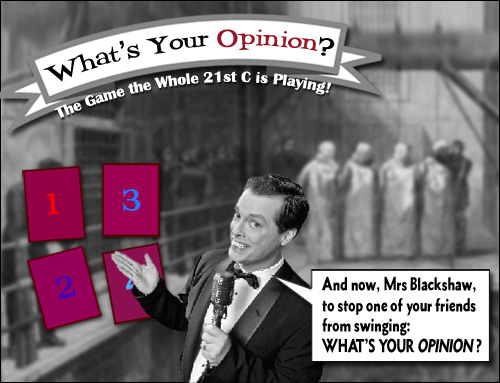
You will recall that a couple of weeks back I had a personal letter from Melissa Rogers, CEO of Shoo!TAG, in which she took me to task for ‘defaming’ her product, and asking why I believed there was no scientific support for it. I clearly outlined my position to her in a manner that I thought didn’t leave much room for interpretation. After receiving her reply this morning, though, I get the distinct impression that she didn’t actually read my letter, so much as skim through it in the way that I assume she approaches scientific literature. This is the sum of what she wrote:
Although I respect the right to your opinion, we obviously do not agree. My question is: What would you do, if you discovered you were wrong?
Dear Ms Rogers,
The entire problem here is that we’re not talking about an issue of opinion. You have made claims that challenge fundamental precepts of science as we currently know it, and you have said quite plainly on your web site that your product uses these novel scientific discoveries to repel insects. By doing so you are not putting forward an opinion that I am merely countering with some contrasting opinion. What you are doing is quite deliberately declaring that you have scientific substantiation of the principles by which you say Shoo!TAG operates. Scientific evidence and opinion are two very different things. Indeed, the scientific process is specifically designed to weed out the influence of opinion.
I believe that you understand very clearly that you need more than just opinions to make Shoo!TAG sound credible to your customers. You want to make it appear that you have science behind your claims, because you know, as we all do, that science works. The trouble is that, although you know lots of scientific buzzwords like ‘quantum’ and ‘electromagnetism’ and ‘fractals’, you don’t really understand much about these things, nor indeed, about the scientific process itself.
On your website, you use every opportunity to attempt to give Shoo!TAG scientific validity, even if it means distorting the truth. You use lots of scientific sounding language, you have a ‘Technology’ page (formerly called ‘Science’) where you talk about your ‘lab’ and ‘experiments’. You have implied repeatedly that you have endorsements by legitimate scientific institutions (which is demonstrably not true), and you publish scientific-looking documents with lots of tables and statistics. Your patent application has pages of technical-sounding language which is plainly contrived to give the impression that there is something scientific going on (when really it makes very little sense to anyone who does understand science).
The primary difference between opinion and science is that an opinion is, by its nature, a subjective stance. Science tries very hard to iron out all subjectivity and make an assessment of facts that can be agreed upon by anyone who cares to observe that assessment.
Let me try to explain this difference with some simple analogies:
In the 18th century, a mathematician named Daniel Bernoulli outlined a principle that showed that in a fluid flowing over an object with differing surface areas, a pressure differential is created on one side. This quite simple observation went on to have profound effects for our modern lives, perhaps the most well-known being the invention of the airplane. The Bernoulli Principle is what keeps aircraft in the air. Now it doesn’t matter what your opinion of Bernoulli’s discovery is; it will work for everyone in exactly the same way. Even if you hold an opinion that Bernoulli ‘just made it all up’, it will still work anyway. Bernoulli’s Principle is a sound scientific idea to which millions of people entrust their lives every day. And it is independent of opinion or belief.
Now let’s consider some colours: twenty shades of some dark red colour, say. We can show those colours to a hundred people and probably get a hundred different opinions on which of those shades might be called ‘purple’ or ‘crimson’ or ‘red’. And we could show them to people in China and Spain and Canada and get more opinions still. But if it came down to whether you would stake your life on the opinion of Gladys Blackshaw of Manchester, England, of whether the card she had in her hand was red, crimson or purple, you simply wouldn’t do it. Why? Because opinion is highly subjective and we don’t trust it for important decisions.
This is why humans came up with the idea of science in the first place: it is the most reliable way we know of assessing the world. What this means is that your opinion or my opinion or anyone else’s opinion is entirely irrelevant when it comes to your claims for how Shoo!TAG is supposed to work, because the only correct way of establishing the validity of your claimed results is with science.
You ask me what I would do if I discovered I was wrong? ((Asking a question like this is a technique much beloved of those who are unable to argue with evidence on their side. By throwing an open-ended query back at the interrogator the argument is deflected away from the issue at hand, which, in this case, is: What kind kind of evidence can they provide that they are right? What I would do if I am wrong is hypothetical and irrelevant to the usefulness of the discussion unless they can demonstrate that they are actually right. They are making the unverified claims, not me.)) Well, the only way that I’m going to ‘discover’ that I’m wrong is if you can demonstrate some good science behind your product. The onus is not on me to prove that I’m right – I’m not the one seeking to sell a product based on remarkable new scientific principles. It’s YOU who are obliged to show the world that you’re right – YOU are the one making money out of this scheme. You have a responsibility to back up your claims. As I have said repeatedly, you can easily bring real science to bear on Shoo!TAG, should you have the courage to do it. It’s not even particularly hard science, as these things go. If you genuinely believe in your product, I simply don’t understand why you wouldn’t seek this kind of widely accepted corroboration. The really impressive thing about proper science is that if you really can scientifically demonstrate the astonishing results you say you can get, I (and everyone else on the planet) will have no choice but to accept your evidence, because the science will bear you out.
It won’t come down to a matter of opinion.
Sincerely
Peter Miller
Wed 19 Oct 2011
Since I last wrote about shoo!TAG here on TCA, I’ve been having some rather interesting correspondence with people at Texas State University regarding a letter that was recently featured on the ShooTag site which was a synopsis of a supposed ShooTag experiment that had been carried out in June under the aegis of the University. The letter, including a precis of the seemingly persuasive results from that experiment, was signed by TSU assistant professor Ken Mix PhD. The document in question appeared to be on a Texas State University letterhead.
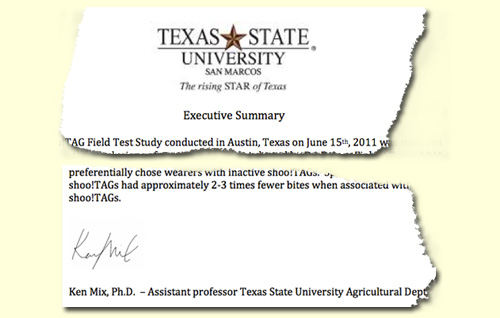
Well, it seems that ShooTag’s claims of Texas State University involvement in this affair were (as I speculated might be the case), not entirely to the liking of the University administration, and Dr Mix wrote to me this morning to inform me that he’d requested that ShooTag take the letter down. ((Which they have – kind of. The link to it is now gone but the pdf itself is still there)) Rather surprisingly Dr Mix inferred that I must have gone out of my way to find the letter, claiming that it was not immediately apparent through the site menus and that he had to perform a search to find it. Au contraire I told Dr Mix. I found it simply by looking under Our Technology -> Testing ShooTag and clicking on the link there, as I expect anyone who was curious about ShooTag’s proposed mechanism of action might have done. ((It’s gone now of course, but it was up and active until a day or so ago.)) I also pointed out to Dr Mix that a quote from him appearing to be an endorsement is, as of this writing, still active on the Australian ShooTag site.

Also in my inbox this morning was an email from Melissa Rogers (ShooTag CEO), who had evidently acquired my private address from Ken Mix or TSU. No matter. As I have said before, I don’t go to particular trouble to protect my real identity and it’s pretty easy to find out who I am even if you’re merely casually inquisitive (jeepers – as it says in the FAQ: just email me and I’ll tell you!) I’m not entirely sure, though, that Ms Rogers had connected the dots when she wrote to me, so she may be surprised to read my reply to her, which I’ve reproduced in full below. In her email she wanted to know why I ‘felt the need to defame’ her product, what my concerns with it are, and why I believe that there is no scientific data or evidence that it works. Well, we’ve been through it all before, but here, set out clearly to Melissa Rogers in person, are my grievances against ShooTag. Happy reading (and stay tuned)!
Dear Ms Rogers,
I will be happy to explain to you why I take exception to your product, but I suspect you are already familiar with my arguments.
First of all, I have nowhere defamed your product. Defamation requires that I have said something about your product that is untrue, and I have not done so. Furthermore, I believe (and can amply demonstrate) that you have engaged in deceitful behaviour regarding the public promotion of your product, and that it is in the public interest to have this behaviour noted.
What I have clearly said, repeatedly, is that there is no reason to think that your ShooTag could ever work by any mechanism currently known to science. Since you are making extraordinary claims that ShooTag operates by using a scientific agency hitherto unknown, the burden of proof is on you to demonstrate clearly and unequivocally that this is the case. To date, you have not shown evidence of that anywhere. If you do have scientific evidence that establishes such an agency or agencies, you need only publish it in a manner that is acceptable and convincing to the scientific community for your claims to be validated. Anecdotal testimony (which you readily use as a substitute for scientific data on your site) is, as you will know if you’ve ever talked to a real scientist, not acceptable as  scientific corroboration of your claims, due to its unreliably subjective nature.
My concerns with ShooTag, are many: firstly, you are taking advantage of people by selling them something which, although it is not supported by any known science, you continually attempt to frame in a scientific context. In other words, you use ‘sciencey’ sounding terms to attempt to make ShooTag sound credible. For a start, you offer up ideas such as the ‘trivector’ mechanism, ‘energy’ fields and the vague concept of biological ‘frequencies’ as if they are proper scientifically supported notions, which they are not. At best these things are speculative, but mostly they are just plain nonsense. In addition to presenting pseudoscience as science, you imply that the mechanism of ShooTag is somehow supported by actual scientific concepts of which you plainly have little comprehension, such as quantum physics, fractal mathematics and Schumann Waves. All these things are meaningless in relation to your product, at least in any way that you have attempted to demonstrate so far. You also use the names of scientists like Albert Einstein and Geoffrey West, whose work you clearly don’t understand, in a manner that suggests that their theories offer support of your own speculations (which they most certainly don’t). This is misleading and irresponsible.
In addition to all this, you regularly refer to scientific ‘experiments’ which you say demonstrate not only that your product works, but that it works extraordinarily well. The experiments you reference either show nothing of the sort (such as your ‘Texas A&M Field Trials’ which were scientifically ridiculous), or don’t have substantiation of any kind (like the supposed ‘European Trials’ which you have mentioned on several occasions on the web but from which you have never provided any data whatsoever, or the supposed supporting video from ‘the Japanese Ministry of Health’ which you boasted about on your site but which never materialised there for anyone to see). You also continue to heavily infer that credible organizations are involved with your product (Texas A&M University, Texas State University, the Japanese Ministry of Health, the Finnish Olympic Team) when it is clear that no such endorsements have been made or were intended (as is quite evident from my conversations with the administration at Texas State University, and their requirement that you remove any such TSU endorsements from your site). Excuse me for saying so, but responsible companies with legitimate products do not undertake this kind of deceptive behaviour.
In short, you want everyone, particularly your prospective customers, to think that ShooTag is validated by science and approved by authoritative institutions, yet you have nothing to support your claims other than self-generated hyperbole and subjective customer testimonials. No science.
I also have concerns that stem from this lack of science and relate to the morality of your product as you present it. As a pet owner (I have three cats) I understand that humans who have pets are completely responsible for the wellbeing of their animals. I believe that people who use your scientifically unproven product to control pests on their animals are depriving them of pest control methods that have been properly scientifically tested and are known to work and to be safe. A pet owner who uses a product like ShooTag that is scientifically baseless is subjecting their pets to unnecessary discomfort and perhaps even to a potential threat of illness.
My concerns about the morality of the sale of your product were increased greatly when you began claiming that ShooTag is effective at controlling mosquitoes on humans. If I was making such a claim on a product of my own, I’d want to be one hundred percent sure that I wasn’t potentially risking someone’s life by giving them erroneous preconceptions about its effectiveness. I would do that by undertaking rigorous science in the way that is generally accepted by anyone who markets any such human-life-critical product (it’s not, for example, the kind of science that you do in an ad hoc way at a Sunday barbecue with people wandering in and out of tents).
Ms Rogers, if you really believe that your product does all the things you claim it does, it is simple to refute all my objections. You just need to arrange for the design of a proper experimental protocol and the execution of double-blind tests carried out by an independent third party. You then need to have those tests replicated elsewhere by similar independent double-blind experiments. I stress the importance of all those elements:
•The experiment should have a proper protocol (a disinterested third party should design the experiment with the aim of disproving your claims. The object of the experiment is disproof. If the claims can’t be disproved, then you are well on the way to having valid claims).
•The experiment should be supervised and carried out by an independent third party (that is, by people who have no affiliation with you, and no investment nor interest in the outcome of the experiment).
•The experiment should be double-blind with proper controls (if you don’t know how a double-blind controlled experiment works, and why experiments need to be done this way, I suggest you do some research).
•The experiment should be reproduceable (you need to show that your results are reliable no matter how many times the experiment is carried out).
•The experiment should be peer-reviewed (that is, scientists who are acknowledged experts in the field, and who are not affiliated with you, should critically examine the experimental protocols and the results) ((It strikes me that this college-level understanding of scientific protocol should be clearly understood by both Rainer Fink and Ken Mix, and yet the Texas A&M trial, at least, makes no effort at all to adhere to scientific rigor. Read about it here and see for yourself. Who knows what Mix’s PhD was, but Fink has both a Bachelor and Masters in Science so he has NO excuse whatsoever.))
If you carry out these tests in an acceptable scientific manner in the way I’ve suggested, and the results confirm your current claims, I will make you some iron clad guarantees:
•I will make a full and public retraction of my assertion that ShooTag cannot possibly work, with my very humble apology for ever doubting you.
•I will be first in line to invest my entire life savings in your product, should you float it (which, under the circumstances would be highly advisable).
•You will have the undying admiration and respect of the science community, the medical profession and the entire world for having discovered two, perhaps even three, completely novel and quite astounding scientific principles.
•Your name will go down in history along with Newton and Einstein for having discovered said principles.
•You will probably win the Nobel Prize for Physics, and possibly Medicine and Peace as well.
So really, by doing some genuine scientific research on ShooTag you have nothing to lose and everything to gain. Indeed, if you have faith in your product, and it really does work, you could easily aspire to being the richest and most respected woman on the planet in a few short years. What good reason could you possibly have for not wanting to do the science?
Sincerely
Peter Miller
___________________________________________________________________________
The Complete Tetherd Cow Shoo!TAG link archive is here.
Sat 10 Sep 2011
In reference to my last post Science Shmience, ((Science Schmience is a term I took directly from the Shoo!TAG site. In my opinion, it illustrates exactly how they view the need for scientific process.)) I thought it might be interesting to spend a little time examining the Shoo!TAG fondness for continuing and relentless revisionism. The following images are archived from the Shoo!TAG site and elsewhere, and have mostly been redacted from their original pages. Unfortunately for Shoo!TAG, unlike the situation with Soviet Cold War records, nothing can ever be completely disappeared from the internet.
Shoo!TAG: What they don’t want you to see anymore, and why.


What? Claims of a successful scientific trial showing Shoo!TAG’s amazing powers, including a clear implication that the experiment was carried out with the imprimatur of Texas A&M University. All traces of this have been completely removed from the Shoo!TAG site. [Although as of this writing the material (excepting the video) can still be seen at genuineshootag.com, a site that seems to have been set up as some kind of bolthole for the taggers ]
Why? The experiment was ludicrous for numerous reasons as we discussed in Shoo Us the Science! Given the comprehensive scouring of all references to it from the site (including from the press release page, where you’d think it would normally remain if this was just a matter of bringing the website up to date), it seems likely that Texas A&M University or Dr Rainer Fink (or both) weren’t happy to have Shoo!TAG using their names.

What? A boast that the Finnish Olympic Team was using the Shoo!TAG ‘people’ product. This appeared on the Johnson Pet Trade Consultants site, which has clear links to Shoo!TAG as is easily seen by a cursory visit. It was removed only days after I questioned it here on TCA. (The site still carries complete references to the Texas A&M Field Trial and Dr Werner Fink. I anticipate that these will be removed pretty quick).
Why? It was simply a lie.

What? A claim that was on the Shoo!TAG Science page, which implied that the Japanese Ministry of Health had tested and was endorsing the product. The supposed link to a video was never forthcoming, even though the claim remained on the page for over a year. It is now gone.
Why? The assumption must be that no such test was ever done, and no such video was ever made. Either that, or the test and the video turned out to be somewhat less flattering than the ShooTaggers anticipated. I am inclined to the first explanation.
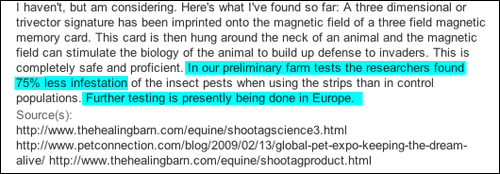
What? A strange, supposedly impartial comment left on a Yahoo Answers page by an ‘anonymous pet owner’ in answer to the question ‘Has anybody tried the ShooTag?’ The reply is undoubtedly from Melissa Rogers or Kathy Heiney (note the spruiking of the ‘trivector’ mechanism and the sudden lapse into personal ‘ownership’ with ‘In our preliminary farm tests…‘). The vague ‘European trials’ claim was also mentioned in other Shoo!TAG postings on various pet lists, and on the Shoo!TAG site. (I also draw your attention here to the mention of the supposed ‘75% effectiveness’ quotient of the Shoo!TAG, some years before that same figure was allegedly ‘proved’ by the ridiculous statistical jiggery pokery of the Texas A&M trial. Is there any clearer indication of the fact that the ShooTaggers knew how they wanted the results from that experiment to pan out well before they even started it? Science? Not even close.)
Why? As in the case of the supposed Japanese Ministry of Health tests, the European trials either didn’t ever exist, or showed Shoo!TAG in a poor light. Again I am inclined toward the former. My personal belief is that the ShooTaggers just make this stuff up because they know that, even though there is no real science to be had, they need to attempt to provide some kind of scientific legitimacy (because customers find that kind of thing impressive, right?)

What? Just one of the numerous references to the criminally indicted ‘Professor’ William Nelson (now Desiré Dubounet) that have been expunged from the Shoo!TAG domain. Nelson’s ideas featured as the sole ‘scientific’ basis for Shoo!TAG’s working principles on earlier versions of the Shoo!TAG site, and Desiré Dubounet is listed as one of the ‘inventors’ on the Shoo!TAG Patent Application.
Why? We’ve discussed Professor Nelson in quite some depth in Shoo!TAG Waterloo. A few minutes reading through that post will give you a clear idea of why no-one in their right mind would want Nelson/Dubounet anywhere near a product they hoped to have even the faintest scientific credibility.
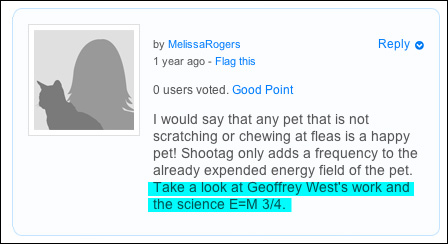
What? Melissa Rogers, Shoo!TAG CEO, shows in her own words how much she knows about science. Every single one of Rogers’ and her fellow CEO Kathy Heiney’s ridiculous pseudoscientific explanations (including several videos) of how Shoo!TAG is meant to work have been thoroughly scrubbed from the currently searchable internet.
Why? I think that is entirely self explanatory.
___________________________________________________________________________
The Complete Tetherd Cow Shoo!TAG link archive is here.
Fri 9 Sep 2011
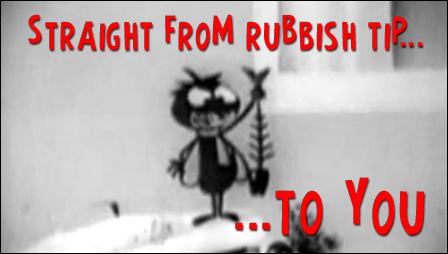
A well-known brand of insect repellent here in Australia used to feature the slogan ‘When you’re on a good thing, stick to it!’ Our old friends from Shoo!TAG don’t have a gadget that can claim any of the repelling power of Mortein, but they certainly understand the value of the slogan.
What I am referring to here, dear Acowlytes, is the ShooTaggers’ unflagging morally bankrupt opportunism: they’re on a good thing with people’s gullibility and willingness to part with their money indiscriminately, and they aim to stick to it.
The ShooTaggers’ latest exploit, which we’ll examine today, involves their apparently boundless capacity for revisionism. We’re all quite familiar with this gambit by now: they claim something in an effort to give their product credibility, it’s challenged, they change it. I can’t even begin to count the number of times this has happened in the last few years. ((This behaviour alone should make you deeply suspicious of them and their motives – people with legitimate products simply do not do this kind of thing.)) We saw it with their erasure of all links to William Nelson/Desiré Dubounet; we saw it with the disappearing of their boast that the Shoot!TAG was being used by the Finnish Olympic Team; we saw it with the excision of Melissa Rogers’ and Kathy Heiney’s daft ‘explanations’ of how the silly thing is meant to work; we saw it with the removal of the idiotic meanderings that comprised Shoo!TAG’s supposed ‘science’ (which were once festooned all over the site like cheap Christmas decorations).
And now it comes as no surprise to see that they have once again altered their website to remove material that made them look a little bit too much like the peddlers of pseudoscience that they are.
You will remember that, a little way back, Shoo!TAG was all up on how wonderful their ‘science’ was, with the loud trumpeting on their home page of the ‘Texas A&M University Field Test’ that supposedly showed that ‘Shoo!TAG is 75% effective against mosquitoes!’ Well, it seems that particular science isn’t really worthy of being featured any longer on the Shoo!TAG site which has recently been scrubbed clean of all references to the clueless experiment.
The link to the video on their ‘How Does it Work’ page that once led to the August 2010 test now returns a 404 error, and gone also is the promise of the supposed test results from a study conducted by the ‘Japanese Ministry of Health’ (like that’s a surprise). Likewise, the announcement of the Texas A&M University Test has disappeared from the Shoo!TAG press release archive where it once featured prominently. Everything for which I took them to task in my post Shoo Us the Science! Is completely gone. ((Have no fear though, erased from the web it may have been, but not from the TCA Shoo!TAG museum!))
One is prompted to wonder why they have gone to all this trouble if they really believed (as they previously claimed) that these tests were so definitive. One reason that springs readily to mind is that they were forced to redact all the relevant material, perhaps by Texas A&M University, or maybe by the scientist who was involved in those tests, Dr Rainer Fink (maybe Dr Fink realised that he was looking like a prize idiot being by being associated with these people).
As a substitute for the Texas A&M endorsement, however, we now have another curious document:
Read the result from our latest field test conducted by Texas State University. Texas State Study Executive Summary Letter June 2011
Note very well that the statement above claims in explicit terms that the test was conducted by Texas State University. I wonder how TSU feels about that? I guess we’ll find out, because I’ve asked them that very question. ((I fully expect the TSU ‘endorsement’ to be altered rapidly in the next few days.))
The link takes us to a another piece of sleight-of-hand by the ShooTaggers. It is nothing more than a letter about a supposed test. I am hugely intrigued here. Could it possibly be that the reason there is a letter but no data from the vaunted trial is that Shoo!TAG is going to attempt to get the experiment peer reviewed? ((It’s likely to be a sobering experience for them, if it is indeed the case…)) Am I completely mad being optimistic that they’ve actually learned something about science? Well we will have to wait and see, I guess. In the meantime, they just can’t resist being as unscientific as always by using the letter (which appears on a Texas State University letterhead… kind of…) ((It looks very much to me like they’ve badly copied the letterhead and then typed what they wanted under it… You be the judge!)) to make even MORE outrageous claims than they did with their last ‘experiment’. Now the Shoo!TAG is showing an 80% reduction in mosquito bites! What’s more, even the deactivated Shoo!TAGs used as controls have a repelling effect under specific circumstances!!! Imagine that!
There also appears to be a transferred effect when the populations were mixed. Males that wore inactive shoo!TAGs received a mean number of bites only 2 times that of active shoo!TAG wearers when in mixed tents. The analysis does indicate mosquitoes preferentially chose wearers with inactive shoo!TAGs. Specifically, wearers of inactive shoo!TAGs had approximately 2-3 times fewer bites when associated with wearers of active shoo!TAGs.
I’d just can’t wait to hear what kind of explanation they’re going to give for that particular effect.
Without actually getting a breakdown of the protocol and the data of this test it’s pretty hard to tell what went on here, but the general sense of the letter conveys the same kind of addle-brained methodology as was evident in the Texas A&M trial. And there is no doubt that it’s presented on the site under the usual Shoo!TAG modus operandi of making it appear that science has endorsed the efficacy of the product without that actually being the case.
It seems to me, Faithful Cowpokes, that Shoo!TAG could more accurately align themselves with another of Mortein’s contributions to popular culture: Louie the Fly. Just like him, Shoo!TAG comes ‘straight from rubbish tip to you!’
[Addendum: Some of the material referred to above still exists on another associated Shoo!TAG site genuineshootag.com. The video seems to have vanished completely off the web, but the Rainer Fink letter of endorsement is still available, as is a pdf of Shoo!TAG CEO Carter McCreary’s amusingly inept breakdown of the trial. It seems they haven’t quite gotten around to sweeping everything under the carpet.]
___________________________________________________________________________
The Complete Tetherd Cow Shoo!TAG link archive is here.
Fri 4 Jun 2010

I’ve been asked by a couple of people if I could make a summary page for all the TCA links in the Shoo!TAG (also ‘ShooBug’) saga, so without further ado, in chronological order…
•And So Ad Infinitum… April 1, 2009: In which I discover ShooTag for the first time and completely fail to make a single joke about April Fool’s Day.
•WooTagâ„¢ April 14, 2009: In which Melissa Rogers from ShooTag takes me to task for not being ‘disaplined’ in quantum physics, calls me ignorant and uses terms like ‘fractal’, ‘crystals’ and ‘energy fields’, and promises that the world will get to see the ‘sceince’ ((Maybe ‘sceince’ is something different to ‘science’? That would explain an awful lot.)) behind ‘all three’ ShooTag applications when they go from patent pending to full patent protection (yeah, like that’s ever going to happen). ((There are no records for a US patent application for anything that resembles ShooTag. I propose that a patent has never been submitted.))
•EXTRA: World’s Zombies Starving! April 17, 2009: In which Melissa Rogers uses her superior knowledge of quantum physics to rewrite Einstein’s famous mass/energy equivalence formula, but somehow fails to be nominated for a Nobel Prize.
•EMF – It’s Not What You Think! August 29, 2009: In which Kathy Heiney and Melissa Rogers ‘explain’ the workings of Shoo!TAG in their own baffling words. Don’t worry if you are more confused after you listen to them – everybody is.
•How Science Works December 7, 2009: In which we examine how the scientific process works and why ShooTag is not related to it in any way.
•Shoo Polish? April 16, 2010: In which we learn that the ShooTag sisters started out by attempting to sell ‘homeopathic stress relieving creams’. Which, all things considered, comes as no surprise.
•Kookaburra or, perhaps… Galah? April 17, 2010: In which someone involved with ShooTag (even though he pretends not to be) attempts to pass himself off as an Australian to our substantial amusement. When we expose his shabby ruse, he turns nasty and calls me names.
•Another Science Experiment May 3, 2010: In which we learn a simple trick for making visible the encoded magnetic data on a credit card. We apply it to a ShooTag in an effort to see just what’s on that sucker.
•Shoo!TAG Unplugged May 19, 2010: In which we reveal, thanks to our intrepid readers, that the ShooTags are encoded with a handful of numbers and the words ‘tick’ and ‘flea’, thus illuminating the simplistic magical thinking of the ShooTag creators. ((Truly, using the same logic, if you hung a bit of cardboard around your pet’s neck with the words ‘Go away fleas!’ written on it, you’d see exactly the same results as you would with a ShooTag.))
•Shoo!TAG: Waterloo May 24, 2010: In which we disclose the full bona fides of the ShooTag creators, including the basis of their pseudoscientific beliefs and their links with the criminally indicted fraudster ‘Professor’ William Nelson.
•Shoo!TAG: Bitchfight June 27, 2010: In which we learn that The Finnish Olympic Team is allegedly endorsing ShooTag, and that the European rollout faces competition from a nemesis, Tic-Clip.
•Advertising Charity Begins at Home November 27, 2010: In which we find that ShooTag is being shipped to Haiti to help control malaria. As if Haiti doesn’t already have enough of a problem.
•Tell Aura I Love Her February 25, 2011: In which we encounter astounding scientific proof of Shoo!TAG’s amazing effects. If you consider pretty rainbow coloured auras as science, that is.
•Shoo Us the Science (Project) February 28, 2011: In which Energetic Solutions, the creators of ShooTag, show the world how much they know about science. Which isn’t very much, needless to say. Oh, and they tell some more lies and make some more exaggerations.
•Shoo!TAG: Crime Against Humanity April 26, 2011: In which Energetic Solutions shows how truly stupid and dangerous they are by boasting about shipping $30,000 worth of Shoo product to Zambia to ‘help fight malaria’
•Shoo!TAG: Patently Absurd June 7, 2011: In which we examine the ShooTag patent application and notice that Professor William Nelson/Desiré Dubounet still has a finger in the Shoo pie.
•Science Schmience September 9, 2011: In which we notice that amazing scientific evidence in support of Shoo!TAG has mysteriously vanished from their website, only to be replaced by more grandiose claims with much flimsier credibility. If that’s even possible.
•Misty Watercolour Memories… September 10, 2011: In which we investigate the way in which the people behind Shoo!TAG doggedly rewrite history to cover up their mistakes, their lies and their general lack of science acumen. With pictorial examples!
•Shoo!TAG Pants Down October 19, 2011: In which the Shoo!TAG claims of endorsements from Texas State University mysteriously disappear from their site, and I publish an open letter to Melissa Rogers.
___________________________________________________________________________
And, as added extra value, here are a few other links of relevance on other sites:
•ShooTag review and testing on dog complete May 2, 2010: Darcie, from The Dish, videotapes a test of the ‘tick’ Shoo!TAG on her dog Oliver. Even though Darcie followed the manufacturer’s instructions to the letter, the results are less than impressive. Ticks are plainly not affected by the Shootag.
•Decoding magnetic strips May 17, 2010: Dewi Morgan’s detailed record of how he analysed the data on the Shootags.
•shoo!Tag testing human mosquito complete May 24, 2010: Darcie, from The Dish, tests the ‘human’ mosquito tag and videos the results. Again, the tag fails to have any effect.
•Shoo!TAG Entry at RationalWiki
•Small piece of plastic magnetic strip achieves what entire planet can’t! Great review of ShooTag at Amazon.
Wed 19 May 2010
Recently on Tetherd Cow Ahead we did a simple science experiment that allowed us to reveal a visual representation of the magnetic data on the stripe of a standard swipe card. You will remember that one of the magnetic cards I examined in that post was the dubious Shoo!TAG, which according to its inventors, is a miraculous device that repels fleas and ticks (and other ‘targeted’ pests!) from you or your pets by using ‘the power of the bio-energetic field which surrounds all living thing to create a frequency barrier’.
It turns out that some pretty smart people read the Science Experiment post, including commenters MomentumV and the inimitable Dewi Morgan. To my great surprise, both MomentumV and Dewi were actually able to look at my images and read the card’s encoded data directly off them – something I had never anticipated as possible – and make some great initial headway in decoding the mysterious power of the Shoo!TAG.
The results were cryptic at first. Surprisingly, all of us missed the significance of the letters A E L F, which appeared on the card, along with a string of numbers. I threw up an image of the second ‘Cat’ tag I had (this one supposed to ward off ticks) and Dewi came up with a clever little javascript to auto-decode ShooTags. A number of things then dropped swiftly into focus. We were looking at the data backwards. You can experience the discovery as it happened in the Comments on that post – it makes for a wonderful scientific ‘Aha!’ moment.
This is what Dewi found when he ran the data through his script (all the technical details of how it was achieved are explained in detail on Dewi’s journal): ((It’s probably the best description of how mag stripes work anywhere on the net – trust me, before Dewi came along, I looked!))
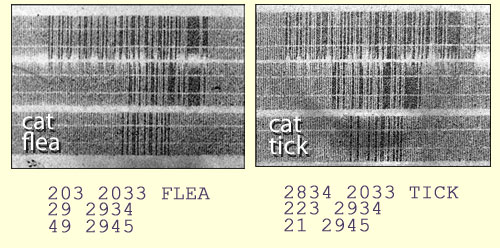
I’ve arranged the characters to correspond with their equivalent position on the cards. Note that the words ‘FLEA’ and ‘TICK’ are actually encoded as letters in the magnetic data.
In the interests of science I decided to expand our dataset, and to this end I acquired a pair of the ‘Dog’ ShooTags from a nearby pet supply shop. ((‘Do you know how they work?’, the sales assistant asked. ‘No-one knows how they work. It’s bunk’, said I. She seemed nonplussed.)) Dewi was kind enough to decode them also:
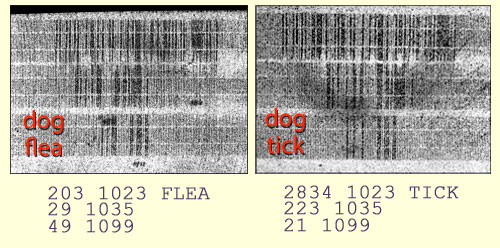
There is some numerical symmetry and repetition apparent here, and the obvious conclusion is that the various numbers simply signify ‘Dog’ or ‘Cat’ and ‘Flea’ or ‘Tick’. ((There are a number of ways the digits can be paired with the actual words in the code or with the animal on which the tag is supposed to be worn.)) Melissa Rogers, one of the CEOs of ShooTag claims, however, that the tags are ‘encoded with earth friendly frequencies’ in the form of a ‘three dimensional or tri-vector signature imprinted onto the magnetic field of the card’ and the ShooTag FAQ says that ‘we are only using the energy field that is already emitted from an animal and adding a few frequencies that we know that specific insects do not like’. The implication is, therefore, that the data on the cards is some kind of numerical representation of these supposedly effective frequencies. I think you will agree with me that it beggars belief to think that anyone would base a serious 21st century product on this concept. It makes wearing a ShooTag the modern equivalent of the old superstitious practice of warding off evil spirits by carrying around a piece of paper with numbers written on it.
Whatever the characters signify, there is no known scientific mechanism that would explain how a few lines of magnetic data in a common encoding format, written to a card that is designed to be swiped through a checkout terminal, could have any effect at all on fleas, ticks, mosquitoes or any other insect.
[NOTE: I think there is still probably some kind of screwy logic to the numbers on the cards – if there’s anyone out there with some expertise in cryptography, or who feels like going on a treasure hunt, any extra information is welcomed. Places to start: Rife Frequencies, Quantum BioEnergetics and Quantum Energy Wellness (where you will see the term ‘tri-vector’ bandied about some more). Who knows whether any of these are relevant in the case of ShooTags, but it would be hugely satisfying to find out…]

















